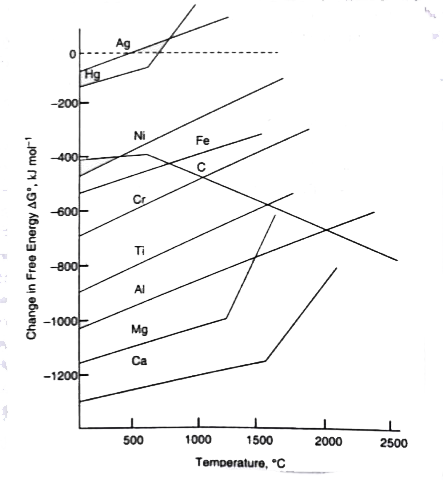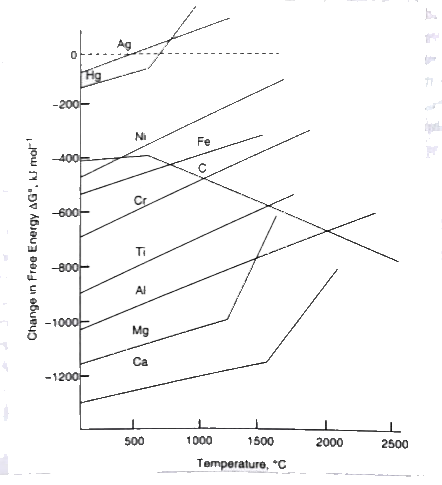In Ellingham diagrams plots of ΔG (oxide formation) show positive slopes except for the formation of CO(g) from coke. Why?
To understand why the Ellingham diagrams show positive slopes for most oxide formations except for the formation of carbon monoxide (CO) from coke (solid carbon), we can break down the explanation into the following steps:
1. Understanding Ellingham Diagrams:
- Ellingham diagrams are graphical representations that plot the Gibbs free energy change (ΔG) for the formation of oxides as a function of temperature. They are used in metallurgy to assess the stability of metal oxides and predict the conditions under which reduction reactions can occur.
2. Formation of Carbon Monoxide:
- The reaction for the formation of carbon monoxide from coke can be represented as:
C(s)+12O2(g)→CO(g)
- In this reaction, solid carbon reacts with oxygen to produce carbon monoxide gas.
3. Gibbs Free Energy Change (ΔG):
- The Gibbs free energy change for a reaction is given by the equation:
ΔG=ΔH−TΔS
- Where ΔH is the change in enthalpy, T is the temperature, and ΔS is the change in entropy.
4. Analyzing the Reaction:
- For the reaction of carbon to form carbon monoxide:
- Enthalpy Change (ΔH): This reaction is exothermic, meaning ΔH is negative.
- Entropy Change (ΔS): The reaction involves the conversion of one mole of solid (C) and half a mole of gas (O2) into one mole of gas (CO). Since the number of gas moles increases, ΔS is positive.
5. Effect of Temperature on ΔG:
- As temperature increases, the negative ΔH and positive ΔS contribute to making ΔG more negative:
ΔG=ΔH−TΔS(with ΔH < 0 and ΔS > 0)
- This means that at higher temperatures, the formation of CO becomes more favorable.
6. Comparison with Other Oxide Formations:
- For most metal oxide formations, the reaction generally involves a gas (O2) being consumed to form a solid oxide. In these cases:
- ΔH is usually negative (exothermic).
- ΔS is negative (since gas is consumed).
- As a result, the slope of the ΔG vs. T graph for these reactions is positive, indicating that they become less favorable at higher temperatures.
7. Conclusion:
- The unique behavior of the formation of CO from coke, with a negative slope in the Ellingham diagram, is due to the combination of a negative ΔH and a positive ΔS that leads to a highly negative ΔG at elevated temperatures, making the reaction favorable.
- Ellingham diagrams are graphical representations that plot the Gibbs free energy change (ΔG) for the formation of oxides as a function of temperature. They are used in metallurgy to assess the stability of metal oxides and predict the conditions under which reduction reactions can occur.
- The reaction for the formation of carbon monoxide from coke can be represented as:
C(s)+12O2(g)→CO(g)
- In this reaction, solid carbon reacts with oxygen to produce carbon monoxide gas.
- The Gibbs free energy change for a reaction is given by the equation:
ΔG=ΔH−TΔS
- Where ΔH is the change in enthalpy, T is the temperature, and ΔS is the change in entropy.
- For the reaction of carbon to form carbon monoxide:
- Enthalpy Change (ΔH): This reaction is exothermic, meaning ΔH is negative.
- Entropy Change (ΔS): The reaction involves the conversion of one mole of solid (C) and half a mole of gas (O2) into one mole of gas (CO). Since the number of gas moles increases, ΔS is positive.
- As temperature increases, the negative ΔH and positive ΔS contribute to making ΔG more negative:
ΔG=ΔH−TΔS(with ΔH < 0 and ΔS > 0)
- This means that at higher temperatures, the formation of CO becomes more favorable.
- For most metal oxide formations, the reaction generally involves a gas (O2) being consumed to form a solid oxide. In these cases:
- ΔH is usually negative (exothermic).
- ΔS is negative (since gas is consumed).
- As a result, the slope of the ΔG vs. T graph for these reactions is positive, indicating that they become less favorable at higher temperatures.
- The unique behavior of the formation of CO from coke, with a negative slope in the Ellingham diagram, is due to the combination of a negative ΔH and a positive ΔS that leads to a highly negative ΔG at elevated temperatures, making the reaction favorable.
Topper's Solved these Questions
- BOOK - AAKASH INSTITUTE ENGLISHCHAPTER - GENERAL PRINCIPLES AND PROCESSES OF ISOLATION OF ELEMENTSEXERCISE - Try yourself33videos
GENERAL PRINCIPLES AND PROCESSES OF ISOLATION OF ELEMENTS
- BOOK - AAKASH INSTITUTE ENGLISHCHAPTER - GENERAL PRINCIPLES AND PROCESSES OF ISOLATION OF ELEMENTSEXERCISE - Exercise19videos
GENERAL PRINCIPLES AND PROCESSES OF ISOLATION OF ELEMENTS
- BOOK - AAKASH INSTITUTE ENGLISHCHAPTER - EQUILIBRIUMEXERCISE - ASSIGNMENT (SECTION -D)20videos
EQUILIBRIUM
- BOOK - AAKASH INSTITUTE ENGLISHCHAPTER - GENERAL PRINCIPLES AND PROCESSES OF ISOLATION OF ELEMENTSEXERCISE - Try Yourself33videos
GENERAL PRINCIPLES AND PROCESSES OF ISOLATION OF ELEMENTS
Similar Questions
In Ellingham diagrams plots of ΔfG (oxide formation) show positive slope except for the formation of CO(g) from coke. Why ?
View SolutionIn Ellingham diagrams plots of ΔfG (oxide formation) show positive slope except for the formation of CO(g) from coke. Why ?
View SolutionEllingham diagrams are plots of ΔG∘1 Vs T for the formation of
View SolutionIn Ellingham diagrams of Δ1G oxide formation Vs T, which of the following graphs has negative slope ?
View SolutionThe choice of reducing agent for metal oxide is decided by thermodynamic principles of metallurgy. ΔG must be negative. Ellingham diagram is a plot of ΔfG0 vs T for the formation of oxides of various elements. All the plots slope upwards when temperature increases. Each plot is a straight line except when some change in phase takes place. A metal will reduce the oxide of other metals which lie above it in this diagram.
At a temperature below 1623 K. Al cannot reduceView SolutionThe value of ΔH for the combustion of C(s) is - 94.4 Kcal. The heat of formation of CO2(g) is :-
View SolutionFor a sponaneous reaction, the free energy change must be negative, ΔG=ΔH−TΔS,ΔH is the enthalpy change during the reaction. T is the absolute temperature, and ΔS is the change in entropy during the reaction. Consider a reaction such as the formation of an oxide
M+O2→MO
Dioxygen is used up in the course of this reaction. Gases have a more random structure (less ordered) than liquid or solids. Consequently gases have a higher entropy than liquids and solids. In this reaction S (entropy or randomness) decreases, hence ΔS is negative. Thus, if the temperature is raised then TΔS becomes more negative,Since, TΔS is substracted in the equation, then ΔG becomes less negative. Thus, the free energy change increases with the increase in temperature.
The free energy changes that occur when one mole of common reactant (in this case dioxygen) is used may be plotted graphically aginst temperature for a number of reactions of metals to their oxides. The following plot is called an Ellingham diagram for metal oxide. Understanding of Ellingham diagram is extremely important for the efficient extraction of metals.

As per the Ellingham diagram of oxides which of the following conclusion is true ?View SolutionFor a sponaneous reaction, the free energy change must be negative, ΔG=ΔH−TΔS,ΔH is the enthalpy change during the reaction. T is the absolute temperature, and ΔS is the change in entropy during the reaction. Consider a reaction such as the formation of an oxide
M+O2→MO
Dioxygen is used up in the course of this reaction. Gases have a more random structure (less ordered) than liquid or solids. Consequently gases have a higher entropy than liquids and solids. In this reaction S (entropy or randomness) decreases, hence ΔS is negative. Thus, if the temperature is raised then TΔS becomes more negative,Since, TΔS is substracted in the equation, then ΔG becomes less negative. Thus, the free energy change increases with the increase in temperature.
The free energy changes that occur when one mole of common reactant (in this case dioxygen) is used may be plotted graphically aginst temperature for a number of reactions of metals to their oxides. The following plot is called an Ellingham diagram for metal oxide. Understanding of Ellingham diagram is extremely important for the efficient extraction of metals.

Which of the following elements can be prepared by heating the oxide above 400∘C ?View SolutionWhich of the following reaction can be used to define the heat of formation of CO2(g) ?
View SolutionThe plot of ΔG versus temperature for the formation of oxides of elements is called
View Solution

